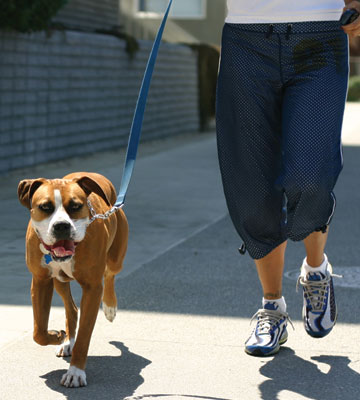So here we are, outside. The door is shut behind us and this very good dog is sitting and waiting for the walk to begin. Are you ready? Make sure you have his attention by saying his name so that he looks at you. Use a command that let's him know it's time to move. "Heel" is traditional, but I use a simple "Let's go!" Then step off and we're walking!
Keeping your dog close is a good idea; he's easier to manage and control, and it reinforces in the dog's mind the idea that you are a team, together. Eyes ahead, you maintain a brisk, steady pace -- don't hurry, but keep a definite "we're going this way, adventure ahoy!" attitude. No stopping to sniff things, no dawdling; you're on a big important walk and here we go. It's all about you, human person, and you decide where to go and how fast. You are the decision-maker.
Now this might be exciting for your dog, and he is probably going to fall into his old habit of charging ahead. That's not how it goes anymore, though, so you have to let him know that there's a better way. Stop, and tell him to sit.
Look at that! Good dog! Wait for a second or two, then get his attention and let him know what to do:"Sparky. Let's go!" and walk on.
Oh wait. You say he didn't sit? He's still pulling?

He's not listening to you. You aren't interesting enough. Remind him that you're there by giving a check on the leash -- a short sharp tug. Do it twice, and if he still isn't listening, then back him up. Walk backwards yourself, and keep checking the leash as you go back: tug, tug, tug. Make a disagreeable sound like "Nah, nah, nah!" to let the dog know you're not happy.
Notice I'm not saying to pull the dog. A long, steady pull gives the dog something to lean against and resist. The uneven tug and release of checking gives him nothing to fight against -- if he tries to lean, he'll lose his balance. He has to keep moving and readjusting himself. It's uncomfortable for him.
Back him up three or four strides and ask him to sit again. No sit? Keep backing. I once backed a dog up half a block before he decided that it was easier to just do as I asked.
What you want to do is make it easy and pleasant to do the right thing, and make doing the wrong thing difficult and unpleasant. Dogs are like anyone else-- they want to be comfortable. Once your dog figures out that walking nicely is comfortable and anything else is no fun, he'll make the right choice.
Once you get that sit, you can cheerfully continue the walk. Get used to mood swings like this when training. Help your dog recognize what makes you happy and what doesn't as he does it. It's no use debriefing him afterwards ("Now Charley, you did great at first, but then you tried to chase that cat and so next time we need to...") Dogs live very much in the moment, so praise or correct right away.
As you walk, keep the leash short but not tight. Your dog will learn that he can be comfortable walking close to you, but if he moves away he gets checked.
 |
This leash has the perfect amount of slack.
(Kindly ignore that wretched chain collar. It's very hard to find pictures of dogs and people walking nicely together and I gotta use what I can.)
|
If you hold your dog close to you on a tight leash, he will be where he's meant to be, but he's not learning to stay there on his own. As soon as you release the tension on the leash, he'll feel the freedom and take off. It doesn't teach him anything and it's a lot of work for you. So let there be a looseness in the leash and give him a check if he starts to move too far away. (This is one of the reasons I hate extendable leashes -- they keep a constant tension, so your dog never learns where he can be comfortable.)
This takes timing and practice, and at the beginning you'll feel like you're nagging that poor dog to death. All beginnings are hard. You'll get it. In the meantime, think of it as you and your dog having a little conversation about figuring stuff out. He's learning, too.
Okay, there's some stuff to work on. Go for a walk! I'll see you next time.

No comments:
Post a Comment